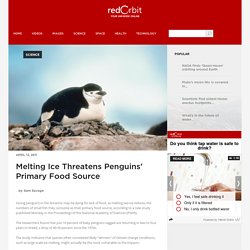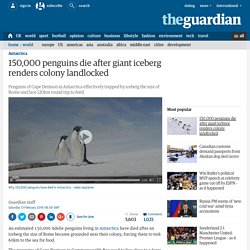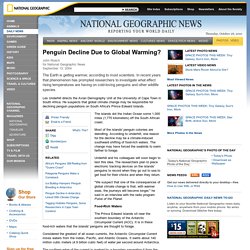

RDG553
Emperor Penguins - Science Nation.
Unhappy Feet: Global Warming Threatens Emperor Penguins. The biggest threat to emperor penguins may not be leopard seals or even killer whales, but a much larger predator: global warming.

Climate Change Could Harm Penguins and Polar Bears. In the Arctic, hungry polar bears, unable to sustain themselves on the melting ice, are increasingly making their way inland to such towns as Noorvik, Alaska, and Churchill, Manitoba, where they sniff out garbage bins and scavenge for dinner.

And in the Antarctic, wet baby penguin chicks shiver in the rain; warming temperatures mean less snow but more rain, which soaks them through, putting them at risk of freezing to death. These are the consequences of climate change, scientists say. Polar bears and penguins may live poles apart, with the great white mammals ruling the Arctic areas near the North Pole and the best-known penguin varieties inhabiting the southernmost regions of the globe, in or near Antarctica. But they both depend on ice and cold for survival—a problem in a world that's warming and where temperature increases are most pronounced at the planet's northern and southern extremes. "They don't share the same areas, [but] they share the same problems," says P.
Penguinscience - understanding penguin response to climate and ecosystem change. Of all the penguins in the world, two kinds need to live in the areas of Antarctica where ice forms on the ocean: the small Adélie Penguin (4 kg or 10 pounds) and the large Emperor Penguin (25kg or 50 pounds).

The lives of these penguins are being altered by changing climate. On land, Adélies (left) are quick, can jump from rock to rock, and climb very steep slopes easily. They build nests out of small rocks, especially those left behind by glaciers. The prefer areas to build nests that are not steep. In contrast, the Emperor (right) is large, slow and clumsy.
Most of Antarctica’s coast is too steep or icy even for Adélie penguins. Melting Ice Threatens Penguins' Primary Food Source - Redorbit. Science April 12, 2011 by Sam Savage Young penguins in the Antarctic may be dying for lack of food, as melting sea ice reduces the numbers of small fish they consume as their primary food source, according to a new study published Monday in the Proceedings of the National Academy of Sciences (PNAS).

The researchers found that just 10 percent of baby penguins tagged are returning in two to four years to breed, a drop of 40-50 percent since the 1970s. Penguins and Global Warming - Penguin Facts and Information. Penguins and Global Warming Even penguins are affected by the climate change that takes place out there.

Due to global warming around the world, their natural environment is affected. Those species that live in the extremely cold regions depend on the ice because it is what they walk on. When it is melting at fast rates it completely changes their natural environment. Penguins starving due to climate change - Technology & Science. Falling populations of penguins in the West Antarctic Peninsula are being driven by a reduction of their main food source, Antarctic krill, according to a new study.

As a result, species such as the chinstrap penguin are much more vulnerable to a warming climate than previously thought, say U.S. scientists from the National Oceanic and Atmospheric Administration. "Long thought to be ecological winners in the climate-warming scenario, the chinstrap penguin instead may be among the most vulnerable species affected by a warming climate," wrote the authors of a study appearing this week in the Proceedings of the National Academy of Science.
Populations of Chinstrap penguins are falling and the loss of sea ice can't be responsible, as the penguins forage in ice-free water in winter. ((iStock)) The scientists have been monitoring colonies of chinstrap penguins (Pygoscelis Antarctica) and the Adélie penguin (Pygoscelis adeliae) in the West Antarctic Peninsula and Scotia Sea for thirty years. 150,000 penguins die after giant iceberg renders colony landlocked. An estimated 150,000 Adelie penguins living in Antarctica have died after an iceberg the size of Rome became grounded near their colony, forcing them to trek 60km to the sea for food.

The penguins of Cape Denison in Commonwealth Bay used to live close to a large body of open water. However, in 2010 a colossal iceberg measuring 2900sq km became trapped in the bay, rendering the colony effectively landlocked. Penguins seeking food must now waddle 60km to the coast to fish. Penguin Decline Due to Global Warming? John Roachfor National Geographic News September 13, 2004 The Earth is getting warmer, according to most scientists.

In recent years that phenomenon has prompted researchers to investigate what effect rising temperatures are having on cold-loving penguins and other wildlife species. Penguin Decline in Antarctica Linked With Climate Change. By John Roachfor National Geographic News May 9, 2001 Emperor penguins like it cold.

Now, scientists have determined that the penguins' susceptibility to climate change accounts for a dramatic decline in their number over the past half century. 'Missing heat' discovery prompts new estimate of global warming: Arctic warming fast. An interdisciplinary team of researchers say they have found 'missing heat' in the climate system, casting doubt on suggestions that global warming has slowed or stopped over the past decade.

Observational data on which climate records are based cover only 84 per cent of the planet -- with Polar regions and parts of Africa largely excluded. Now Dr Kevin Cowtan, a computational scientist at the University of York, and Robert Way, a cryosphere specialist and PhD student at the University of Ottawa, have reconstructed the 'missing' global temperatures using a combination of observations from satellites and surface data from weather stations and ships on the peripheries of the unsampled regions.